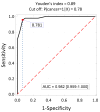Analysis of Risk Factors with Assessment of the Impact of the Microbiome on the Risk of Squamous Cell Carcinoma of the Larynx
- PMID: 39458051
- PMCID: PMC11508926
- DOI: 10.3390/jcm13206101
Analysis of Risk Factors with Assessment of the Impact of the Microbiome on the Risk of Squamous Cell Carcinoma of the Larynx
Abstract
Introduction: Head and neck squamous cell carcinoma (HNSCC) ranks sixth among cancers in the world, and the 5-year survival rate ranges from 25% to 60%. The risk factors for HNSCC are primarily smoking, alcohol consumption and human papillomavirus (HPV). Data indicate that 15-20% of cancers are caused by infectious agents, 20-30% by smoking and 30-35% by unhealthy lifestyles, diet, lack of physical activity and obesity. Dysbiosis is a microbiome imbalance, which promotes oncogenesis by intensifying inflammatory processes and affecting the host's metabolism. Profiling the microbiome in various types of cancer is currently the subject of research and analysis. However, there is still little information on the correlation of the microbiome with HNSCC and its impact on oncogenesis, the course of the disease and its treatment. Objective: The aim of the study was to prospectively assess risk factors with assessment of the impact of the microbiome on the risk of squamous cell carcinoma of the larynx. The study included a group of 44 patients diagnosed with squamous cell carcinoma of the larynx and 30 patients from the control group. Results: In the control group, bacteria of the normal microbiome dominated-the genus Streptococcus, Gemella, Neisseria and Kingella. In the group of patients with laryngeal cancer, Prevotella, Clostridiales and Stomatobaculum were found significantly more often. Porphyromonas, Fusobacterium, Lactobacillus, Actinobacteria, Actinomyces and Shaalia odontolytica were also found at a higher percentage in the study group. Analyzing the phylum, Firmicutes dominated in the control group; there were statistically significantly more of them than in patients from the study group. Bacteroides and Bacillota were found significantly more often in patients with laryngeal cancer. Conclusions: The importance of the microbiome in oncology has been confirmed in many studies. Independent risk factors for laryngeal cancer were primarily a lower number of Firmicutes in the microbiome, but also an increased leukocyte level above 6.52 × 103/mm and a decreased total protein level below 6.9 g/dL. Prevotella, Clostridiales, Stomatobaculum, Porphyromonas, Fusobacterium, Lactobacillus, Actinobacteria, Actinomyces and Shaalia were considered to be the bacteria contributing to the development of laryngeal cancer. Streptococcus, Gemella, Neisserie and Kingella were considered to be protective bacteria. Moreover, the study confirmed the significant impact of smoking, alcohol consumption and poor oral hygiene on the development of laryngeal cancer. The microbiome, its identification and manipulation may constitute a breakthrough discovery for improving the diagnosis and oncological therapy of laryngeal cancer, and also of the entire group of HNSCC. Profiling the microbiome may allow for personalized therapy related to its modification. Assessing the microbiome of patients diagnosed with cancer may provide an opportunity to predict treatment response and effectiveness.
Keywords: dysbiosis; head and neck cancer; laryngeal cancer; microbiome; risk factors.
Conflict of interest statement
The authors declare no conflicts of interest. The funders had no role in the design of this study; in the collection, analyses, or interpretation of data; in the writing of the manuscript, or in the decision to publish the results.
Figures


Similar articles
-
Assessment of Prognostic Factors, Clinical Features Including the Microbiome, and Treatment Outcomes in Patients with Cancer of Unknown Primary Site.Cancers (Basel). 2024 Oct 8;16(19):3416. doi: 10.3390/cancers16193416. Cancers (Basel). 2024. PMID: 39410035 Free PMC article.
-
Association of Oral Microbiome With Risk for Incident Head and Neck Squamous Cell Cancer.JAMA Oncol. 2018 Mar 1;4(3):358-365. doi: 10.1001/jamaoncol.2017.4777. JAMA Oncol. 2018. PMID: 29327043 Free PMC article.
-
The Influence of the Microbiome on the Complications of Radiotherapy and Its Effectiveness in Patients with Laryngeal Cancer.Cancers (Basel). 2024 Nov 1;16(21):3707. doi: 10.3390/cancers16213707. Cancers (Basel). 2024. PMID: 39518144 Free PMC article.
-
Dysbiosis Patterns in Glottic and Laryngeal Cancers: A Systematic Review of Microbiome Alterations.J Voice. 2025 Mar 10:S0892-1997(25)00083-9. doi: 10.1016/j.jvoice.2025.02.036. Online ahead of print. J Voice. 2025. PMID: 40069023 Review.
-
Implications of oral dysbiosis and HPV infection in head and neck cancer: from molecular and cellular mechanisms to early diagnosis and therapy.Front Oncol. 2023 Dec 18;13:1273516. doi: 10.3389/fonc.2023.1273516. eCollection 2023. Front Oncol. 2023. PMID: 38179168 Free PMC article. Review.
Cited by
-
Immunosuppression and Outcomes in Patients with Cutaneous Squamous Cell Carcinoma of the Head and Neck.Clin Pract. 2025 Jan 17;15(1):21. doi: 10.3390/clinpract15010021. Clin Pract. 2025. PMID: 39851804 Free PMC article.
-
Exploring the Antitumor Mechanisms of Bai-Hua-She-She-Cao and Ban-Zhi-Lian against Head and Neck Squamous Cell Carcinoma: A Study on Natural Anticancer Therapeutics.ACS Omega. 2025 Jul 31;10(31):34528-34538. doi: 10.1021/acsomega.5c03068. eCollection 2025 Aug 12. ACS Omega. 2025. PMID: 40821538 Free PMC article.
References
-
- Gatta G., Botta L., Sánchez M.J., Anderson L.A., Pierannunzio D., Licitra L. EUROCARE Working Group: Prognoses and improvement for head and neck cancers diagnosed in Europe in early 2000s: The EUROCARE-5 population-based study. Eur. J. Cancer. 2015;51:2130–2143. doi: 10.1016/j.ejca.2015.07.043. - DOI - PubMed
Grants and funding
LinkOut - more resources
Full Text Sources

